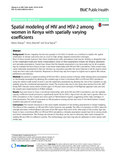Spatial modeling of HIV and HSV-2 among women in Kenya with spatially varying coefficients

View/
Date
2016Author
Okango, Elphas L.
Mwambi, Henry
Ngesa, Oscar
Metadata
Show full item recordAbstract
Background: Disease mapping has become popular in the field of statistics as a method to explain the spatial distribution of disease outcomes and as a tool to help design targeted intervention strategies. Most of these models however have been implemented with assumptions that may be limiting or altogether lead to less meaningful results and hence interpretations. Some of these assumptions include the linearity, stationarity and normality assumptions. Studies have shown that the linearity assumption is not necessarily true for all covariates. Age for example has been found to have a non-linear relationship with HIV and HSV-2 prevalence. Other studies have made stationarity assumption in that one stimulus e.g. education, provokes the same response in all the regions under study and this is also quite restrictive. Responses to stimuli may vary from region to region due to aspects like culture, preferences and attitudes. Methods: We perform a spatial modeling of HIV and HSV-2 among women in Kenya, while relaxing these assumptions i.e. the linearity assumption by allowing the covariate age to have a non-linear effect on HIV and HSV-2 prevalence using the random walk model of order 2 and the stationarity assumption by allowing the rest of the covariates to vary spatially using the conditional autoregressive model. The women data used in this study were derived from the 2007 Kenya AIDS indicator survey where women aged 15–49 years were surveyed. A full Bayesian approach was used and the models were implemented in R-INLA software. Results: Age was found to have a non-linear relationship with both HIV and HSV-2 prevalence, and the spatially varying coefficient model provided a significantly better fit for HSV-2. Age-at first sex also had a greater effect on HSV-2 prevalence in the Coastal and some parts of North Eastern regions suggesting either early marriages or child prostitution. The effect of education on HIV prevalence among women was more in the North Eastern, Coastal, Southern and parts of Central region. Conclusions: The models introduced in this study enable relaxation of two limiting assumptions in disease mapping. The effects of the covariates on HIV and HSV-2 were found to vary spatially. The effect of education on HSV-2 status for example was lower in North Eastern and parts of the Rift region than most of the other parts of the country. Age was found to have a non-linear effect on HIV and HSV-2 prevalence, a linearity assumption would have led to wrong results and hence interpretations. The findings are relevant in that they can be used in informing tailor made strategies for tackling HIV and HSV-2 in different counties. The methodology used here may also be replicated in other studies with similar data.
URI
https://bmcpublichealth.biomedcentral.com/articles/10.1186/s12889-016-3022-0http://hdl.handle.net/123456789/3021
Collections
- Journal Articles (PAS) [263]
